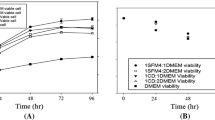Abstract
Hybridoma SPO1 cells were immobilized in calcium alginate beads and were further grown in a fluidized-bed perfusion system with a protein-free medium. The presence of serum in the steps of entrapment was shown to be helpful for the preservation of cell viability. Each step during immobilization was investigated with respect to the extent of cell damage caused. The immobilization process using small beads caused a lower cell viability initially but allowed a higher rate of cell growth subsequently, compared to those in large beads. In a perfusion system for the continuous production of monoclonal antibodies (MAb), the viable cell density reached 2×107 cells per ml of beads with a viability of 40%. Compared with the cells in suspension culture, the immobilized SPO1 cells showed higher viable cell based specific rates of substrate uptake (glucose and glutamine) and of MAb production. A significant drop in the formation of lactate after the cell growth entered a steady state suggested a higher activity of the Tricarboxylic Acid Cycle in the cells when the cell density became high.
Similar content being viewed by others
References
Altshuler GL, Dziewulski DM, Sowek JA & Belfort G (1986) Continuous hybridoma growth and monoclonal antibody production in hollow fiber reactors-separators. Biotechnol. Bioeng. 28: 646–658
Bliem R, Oakley R, Matsuoka K, Varecka R & Taiariol V (1990) Antibody production in packed bed reactors using serum-free and protein-free medium. Cytotechnol. 4: 279–283.
Cahn F (1990) Biomaterials aspects of porous microcarriers for animal cell culture. Trends in Biotechnol. 8: 131–136.
Duff R (1985) Microencapsulation technology: a novel method for monoclonal antibody production. Trends in Biotechnol. 3(7): 167–170.
Familletti PC & Nicoll DD (1989) Gel immobilized cell culture. Inter. Biotechnol. Lab. 6: 16–25.
Hu W-S & Peshwa M (1991) Animal cell bioreactors — Recent advances and challenges to scale-up. Can. J. Chem. Eng. 69: 409–420.
Iijima S, Mano T, Taniguchi M & Kobayashi T (1988) Immobilization of hybridoma cells with alginate and urethane polymer and improved monoclonal antibody production. Appl. Microbiol. Biotechnol. 28: 572–576.
Kamihira M, Yoshida H, Iijima S & Kobayashi T (1990) Effects of oxygen aeration on production of monoclonal antibody in immobilized hybridoma-cell bioreactor. J. Fermen. Bioeng. 69(5): 311–312.
Kwong C-W, Hsieh J-H, Syu MJ & Chou SS (1989) Anti-Hepatitis B surface antigen monoclonal antibody IgM production in suspension and immobilised cell bioreactors. Biotechnol. Lett. 2(6): 377–382.
Lee GM, Chuck AS & Palsson BO (1993) Cell culture conditions determine the enhancement of specific monoclonal antibody productivity of calcium alginate-entrapped S3H5/g2A2 hybridoma cells. Biotechnol. Bioeng. 41: 330–340.
Luan YT, Mutharasan R & Magee WE (1987) Factors governing lactic acid formation in long term cultivation of hybridoma cells. Biotechnol. Lett. 9(11): 751–756.
Lyderson BK (1987) Perfusion cell culture system based on ceramic matrices. In: Lyderson BK (ed.) Large-Scale Cell Culture Technology. pp. 169–192. Hanser Publications, New York.
Mazid MA (1993) Biocatalysis and immobilized enzyme/cell bioreactors. Bio/Technol. 11(6): 690–695.
Nilsson K, Birnbaum S, Flygare S, Linse L, Schroder U, Jeppson U, Larsson PO, Mosbach K & Brodelius P (1983) A general method for the immoblilization of cells with preserved viability. Eur. J. Appl. Microbiol. Biotechnol. 17: 319–326.
Nilsson K & Mosbach K (1980) Preparation of immobilized animal cells. FEBS Lett. 118(1): 145–150.
Overgaard S, Scharer JM, Moo-Young M & Bols NC (1991) Immobilization of hybridoma cells in chitosan alginate beads. The Can. J. Chem. Eng. 69: 439–443.
Piret JM, Devens DA & Cooney CL (1991) Nutrient and metabolite gradients in mammalian cell hollow fiber bioreactors. Can. J. Chem. Eng. 69: 421–428.
Posillico EG (1986) Microencapsulation technology for large-scale antibody production. Bio/Technol. 4: 114–117.
Racher AJ, Looby D & Griffiths JB (1990) Studies on monoclonal antibody production by a hybridoma cell line (C1E3) immobilised in a fixed bed. porosphere culture system. J. Biotechnol. 15: 129–146.
Reid S, Randerson DH & Greenfield PF (1987) Amino acid determination in mammalian cell culture supernatants, Aust. J. Biotechnol. 1(2): 69–72.
Shen BQ (1991) Immobilization of hybridoma cells. Ph. D. Dissertation. The University of Queensland, Brisbane, Australia.
Shen BQ, Reid S & Greenfield PF (1992) Continuous monoclonal antibody production by a composite gel perfusion bioreactor in a protein-free medium. In: Murakami H Shirahata S & Tachibana H (ed.) Animal Cell Technology: Basic & Applied Aspects. Vol. 4 (pp. 173–176) Kluwer Academic Publishers, Dordrecht, The Netherlands.
Shen BQ, Reid S & Greenfield PF (1993) Examination of polysaccharides for their uses in hybridoma cell culture. Biotechnol. Lett. 7(3): 193–198.
Shirai Y, Hashimoto K, Yamaji H & Tokashiki M (1987) Continuous production of monoclonal antibody with immobilized hybridoma cells in an expanded bed fermenter. Appl. Microbiol. Biotechnol. 26: 495–499.
Shirai Y, Sasaki R, Hashimoto K, Kawahara H, Hitomi K & Chiba H (1988) Continuous production of erythropoietin with immobilized animal cells. Appl. Microbiol. Biotechnol. 29: 544–549.
Sinacore MS, Creswick BC & Buehler R (1989) Entrapment and growth of murine hybridoma cells in calls in calcium alginate gel. Bio/Technol. 7: 1275–1279.
Author information
Authors and Affiliations
Rights and permissions
About this article
Cite this article
Shen, B., Greenfield, P. & Reid, S. Calcium alginate immobilized hybridomas grown using a fluidized-bed perfusion system with a protein-free medium. Cytotechnology 14, 109–117 (1994). https://doi.org/10.1007/BF00758175
Received:
Accepted:
Issue Date:
DOI: https://doi.org/10.1007/BF00758175




